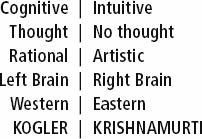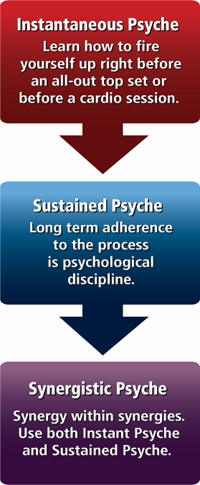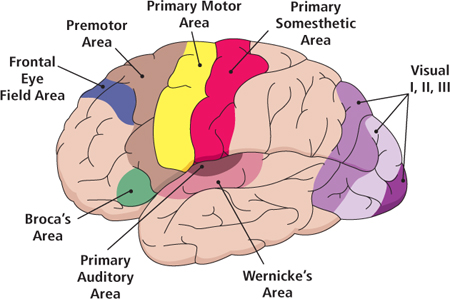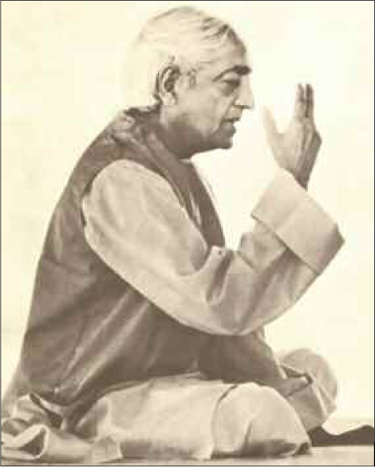

Two psychological geniuses have crossed my path during my life journey: Jiddu Krishnamurti and Aladar Kogler. Each man stakes out one extreme of the Brain Train conundrum. Iron Mentor Bill Pearl was once asked what is the single most difficult muscle to develop? “The brain.” He said only half joking.
People seeking physical transformation think the process is strictly about the training and nutrition. While it is true that proper training and nutrition are the tools we use for eliciting gains, unless the individual is motivated to wield these tools consistently and persistently, the tools are worthless. Motivation, consistency and persistence are critical mental attributes; each is needed in ample amounts if we are to be successful in our physical renovation efforts.
The important first battle in the war to transform is motivating oneself to begin the process. Training and nutrition are critical and must be properly instituted and implemented. Simultaneously a monumental battle is fought on a parallel playing field over force of habit. Ingrained bad habits must be modified or the effort to morph the body is doomed to failure. If the trainee is successful in their efforts to mentally recalibrate, detrimental habits can be overcome. Modification of ingrained habits is accomplished by maneuvering the mind: willpower can be used initially to gain a toehold (as we shall discuss) but willpower only takes you so far.
Experience teaches us that for those seeking to change existing detrimental habits into beneficial new habits, the first fourteen days are critical. The first two weeks usually determine success or failure. The phantom precursor needed to ignite physical progress is mental recalibration.
Willpower is the ability to force yourself into doing something that you don’t want to do. Willpower is not the key to triggering a true transformation. Willpower is initially used to jump start the process. The transformative process must eventually be powered by enthusiasm if it is to succeed.
There are three transformative tools: weight training, cardiovascular training and nutrition. Initially the Purposefully Primitive template may seem complicated, confusing and cumbersome. You do what you are supposed to do and settle in. At first we use willpower to power the process. After a few days things become clear. The individual feels better. This is critical both physiologically and psychologically. By performing cardio, lifting weights and cleaning up the diet, very real biological changes occur within a matter of days. The trainee develops more energy and vitality. If the process is executed as it should be, at the end of fourteen days, tangible biologic and physical changes are visibly apparent. Nothing motivates a person more than losing body fat, adding muscle and feeling flat better; more energy, more endurance, more vibrancy. The individual thinks, wow! If I can look, act and feel this much better in just fourteen days—imagine my improvement after fourteen weeks! At this juncture enthusiasm takes over from willpower in powering the process.
When enthusiasm enters the picture, enthusiasm generated by irrefutable physical change, discipline becomes effortless. This is a predictable and expected phenomenon that occurs every single time an individual commits totally to the Purposefully Primitive process. We use willpower for a few days or weeks until tangible change becomes apparent. This triggers enthusiasm. Transformation of the human body originates in the mind of the trainee. When real results appear, the trainee comes to enjoy, look forward to, and crave the intense training and regimented eating. Once the trainee develops a love for the process, a real corner is turned and the person never again looks at fitness, training and diet in the same way.
The battle to recalibrate the brain is a riddle wrapped in an enigma tucked neatly inside a paradox. What we seek is effortlessness. Entrenched habits die a quick death when the mind is presented with better options. Those who succeed are those who initially use willpower to commence the process, yet understand the finiteness of Will as a mental propellant. We use willpower in those critical first days and weeks to overcome force of habit, knowing that when willpower exhausts itself, another mental propellant comes online to carry the process forward; a mental propellant that is self-regenerating, the mental equivalent of solar power: enthusiasm.
Is it possible to make hard training and disciplined eating fun and enjoyable? Absolutely. How do we get to a place where we actually derive primordial joy from training and look forward to eating foods that help instead of foods that harm? We use our brain to set up effective training and eating regimens that actually work. We train with passion and eat with gusto and zeal. Intense training triggers the release of endorphins, a powerful hormonal cocktail that transforms intense physical training into a joyful experience. In a week or two very real, very tangible physical and psychological changes appear. Now the process gains real traction.
 Hard and intense weight training causes the release of endorphins into the bloodstream. This narcotic-like substance creates a sense of wellbeing that has to be experienced to be understood. The feeling is pleasantly addictive; a legal high and unlike other altered states this high is beneficial, not detrimental, desirous not toxic.
Hard and intense weight training causes the release of endorphins into the bloodstream. This narcotic-like substance creates a sense of wellbeing that has to be experienced to be understood. The feeling is pleasantly addictive; a legal high and unlike other altered states this high is beneficial, not detrimental, desirous not toxic.
 Hard and intense cardio training creates this same physiological phenomenon. The endorphin rush associated with intense aerobic activity is called “runner’s high.” The runner’s high can be acquired using any cardio mode, even walking. Intensity is the trigger.
Hard and intense cardio training creates this same physiological phenomenon. The endorphin rush associated with intense aerobic activity is called “runner’s high.” The runner’s high can be acquired using any cardio mode, even walking. Intensity is the trigger.
 Another source of real enthusiasm comes from tracking progress. The use of training logs creates a sense of momentum. Weight training and cardiovascular training both lend themselves to numeric report cards. Those new to the process are able to see very real, substantive, mathematical, tangible progress on a consistent basis. I have had beginners make uninterrupted progress in every single training session for three straight months. This type of improvement is not difficult for untrained and out-of-shape people. It is easy for a beginner to create skyrocket progress in lifting and cardio if they are lucky enough to find the right training and eating tactics. Elite athletes review progress weekly.
Another source of real enthusiasm comes from tracking progress. The use of training logs creates a sense of momentum. Weight training and cardiovascular training both lend themselves to numeric report cards. Those new to the process are able to see very real, substantive, mathematical, tangible progress on a consistent basis. I have had beginners make uninterrupted progress in every single training session for three straight months. This type of improvement is not difficult for untrained and out-of-shape people. It is easy for a beginner to create skyrocket progress in lifting and cardio if they are lucky enough to find the right training and eating tactics. Elite athletes review progress weekly.
 This feeling of gaining real traction generates something the untrained and out-of-shape person has never experienced: a genuine enthusiasm for physical training. The fact that they are understanding the process, the fact that they are seeing real progress, progress in their poundage handling ability, progress in their cardio efforts, progress in how they feel and act, progress in terms of their weekly report cards…it all adds up and creates an enthusiastic feeling. “Finally! I am onto a system and a method that makes sense, a system that is delivering what is promised; a system that I understand and feel good about doing. I now don’t dread intense workouts—I look forward to intense workouts!”
This feeling of gaining real traction generates something the untrained and out-of-shape person has never experienced: a genuine enthusiasm for physical training. The fact that they are understanding the process, the fact that they are seeing real progress, progress in their poundage handling ability, progress in their cardio efforts, progress in how they feel and act, progress in terms of their weekly report cards…it all adds up and creates an enthusiastic feeling. “Finally! I am onto a system and a method that makes sense, a system that is delivering what is promised; a system that I understand and feel good about doing. I now don’t dread intense workouts—I look forward to intense workouts!”
 All this can occur within fourteen days; fourteen days that can change the direction of a person’s life.
All this can occur within fourteen days; fourteen days that can change the direction of a person’s life.
The most difficult mind battle is overcoming nutritional habit-force. Food habits are ingrained from childhood and the battle to overcome taste addiction requires subtlety and tact. We all have certain foods that we like to eat and that are perfectly acceptable in our new Performance Eating regimen. Psychologically, we seek to identify those healthy and acceptable foods we like to eat and make them the backbone of our new relationship with food. We understand the futility in trying to suppress the chokehold that taste has on us. Instead of suppression and repression we utilize taste to our advantage. We recalibrate our relationship with food. Once we are able to develop a repertoire of foods that we like to eat and are beneficial; once we learn how to prepare these beneficial foods quickly and easily; once we discover how to infuse great taste into foods that are good for us; dieting ceases to become a battle. By using taste to our advantage food becomes our biggest ally instead of our main impediment.
Two men have helped me immensely in understanding how and why we think the way we do. These two men taught me how to change how I think. Each man has provided me an immediately applicable, usable mental template. Too often nowadays the psychological approach towards fitness is either touchy-feely New Age garbage or Brusque Brutes spouting Hitlerian fitness platitudes, invoking willpower and discipline. The first approach is couched in fuzzy, furry, friendly phrases and feel-good bon mots about “getting in touch with ourselves.” At the other ridiculous extreme are fitness Brown Shirts, morons that scream “No Pain No Gain!” and “You just don’t want it bad enough!” We reject these psychological surface skimmers.
A passionate and recalibrated Mindset elevates the individual’s performance during the workout session. When we learn to love the sweat and exhilaration of hard training, a dramatic corner has been turned. A recalibrated Mindset provides us with that infinite mental propellant: genuine enthusiasm.

So who are these two mental masters and what do they have to say that might be relevant to our particular quest? Krishnamurti is the master of the intuitive. He stresses that we need to access a wordless state of vibrant, electric alertness. This state of mind emerges out of profound mental silence. Aladar Kogler is the cognitive genius. He uses rational thinking and organized thought to create structures of extreme logic.

Other mentors taught me how to train, how to eat, how to improve athletic performance, how to write— Krishnamurti taught me how to think. Or more accurately he taught me how not to think. I had noticed during my long and extensive athletic career that at times of peak athletic performance, I was mentally silent. I was super-alert, acting and reacting. Whether thundering off-tackle or pushing upwards underneath a limit squat or overhead press, I was not thinking, I was doing! I might have been thinking up until the ball was snapped or up until the barbell was in motion, but once the deal was on, I was not thinking about how to do what it was I was doing. I certainly wasn’t preoccupied with thinking about totally unrelated matters. I long noted that during intense athletic moments I wasn’t consciously thinking about anything yet I was aware of everything.

In the middle of furious athletic battle, be it with an opponent or a barbell, things unfold too fast for the conscious, rational mind to participate. You come to rely on ingrained training and intuition. In the 70’s I was introduced to yoga, Zen, Hinduism and Taoism and was struck that meditating monks sought a state of ‘no mind’ wherein internal dialogue ceased, allowing ‘original mind’ to emerge. That synced up with my own no-mind athletic experiences and I wondered if athletic no-mind should or could be carried over into everyday life.
Those athletes able to access The Zone (the Americanized phrase for no-mind) sought The Zone because they recognized that they performed better when in its throes. I waded through all the methods and modes used by the mystics and seers and eventually came to a man that used ‘no-system’ to arrive at ‘no-mind.’ To say I was intrigued would be an understatement. Krishnamurti was a no-nonsense iconoclast that punched holes in everything I’d learned to that point. It was his contention that all systems used to quiet the mind were inherently flawed. How do you resolve the inherent contradiction of using a mechanical, rote system, devised by the conscious mind, as a doorway to true mental silence? Riddle me that Batman!
He irreverently pointed out that ritualistic methods were merely mental tricks. You were still playing within the box of the mind when what was needed was to step outside the box. The mind could not be quieted—truly quieted—using thought. All systems were the product of conscious thought. By definition this was an irresolvable contradiction in terms. How could true mental silence be arrived at following a system constructed by conscious thought? What a paradox! This was subtle and appealing to me. He contended that the mind could never be forced or subjugated into silence. You can’t use willpower to suppress thought. Only through ‘negation,’ only by sorting through the falsehoods would we eventually arrive at ‘real truth,’ Wu Wei, as the Taoists called it, The Way of Emptiness. It was, and is, an intriguing concept, enthralling me for thirty years.
His contention, that “the cessation of thought is the awakening of intelligence” synced up perfectly with my own peak athletic experiences. It made perfect sense to me that the human brain, like any other muscle, needs rest. By learning how to ‘not think,’ the brain muscle would be given a much needed respite. When rested and refreshed, then called back into action, the fresh brain, like a fresh muscle, would function far better than an over-used, over-heated brain. The dilemma of ‘not thinking’ can not be forced; methods that dull the mind or beat the mind into submission are mental wolves hidden in sheep’s clothing. To arrive at real mental silence, he suggested, was a matter of being able to be in the absolute, instantaneous present.
I continually experienced being in the present in the middle of a savage workout. Become completely and utterly involved in what it is you are currently doing and the mind falls silent. This synced up with my own rudimentary discoveries. Being in the mindless present was a grand and addictive feeling. I sensed the truth of what he said. I repeatedly lost all sense of self in intense training and craved it. I asked him about this and he smiled and told me to “Carry this lack of center over into day to day life.” That single sentence response has given me enough to work on for over twenty years.
He was always insightful and fierce; even at the very end, as his body was failing him his insight and power of reasoning were awesome and inspirational. He moved me as few men have. He taught me to become immersed in the immediate present. Be aware that the eternal chatterbox, the thinker, the observer, needs to be silent if the brain is to rest itself and revive. Ceaseless internal commentary prevents us from perceiving reality. Reality always unfolds in the absolute immediate present. If you are thinking, you are unable to perceive reality: you are preoccupied and distracted by the intrusive internal commentator. When thought falls silent you experience a vibrant, electric, hypersensitive alertness and aliveness. Intense physical training is the surest way I know to quiet the mind, experience the present and access The Zone.
Iron Curtain Brain Train Grand Maestro
Aladar Kogler is a mysterious Hungarian largely responsible for formulating the Iron Curtain Brain Train methodology used for applied athletics. Kogler and his cohorts were the Mind Masters behind the Big Red Machine back in the halcyon days when communist athletes were routinely decimating and dominating opponents at World Championships and the Olympic Games with yawning regularity. With the full weight of state sponsorship behind their sport’s apparatus, no expense was spared to produce showcase athletes that could and would demonstrate to the World the superiority of totalitarian societies.
Of course we now understand that this system had a slimy underbelly: athletes were treated as patients, jacked up on steroids and testosterone then discarded like human rubbish when the first flaw or performance decline was detected. The rest of the athletic world was suspicious yet ignorant when robotic communist athletes, stuffed to the gills with the finest performance enhancing drugs known to man, beat the rest of the naïve world stupid. Later, when the advent of drug testing came to pass in the early 1970’s, the Red Medical people created designer drugs that were stealthy and undetectable. The state supported sports machines resorted to every illegal trick in the book. The Reds created an army of paid professionals to compete against pathetic amateurs, real people that had to hold down day jobs in order to survive. It was the most un-level of playing fields.
Dr. Kogler didn’t deal in dark-side black arts. He took psychiatry and psychology and molded them into a systematized Brain Train program that became universally used behind the Iron Curtain. He immigrated to the United States in 1981. A Czechoslovakian native, he lived in Hungry and over time developed a mental system that was honed and refined and battle-tested for decades. I interviewed him on numerous occasions for magazine articles and became enamored with his cerebral approach. His book, Clearing the Path to Victory; Self-guided Mental Training Programs for Athletes was largely ignored in this country. This was criminal: Clearing the Path was a benchmark book, a no-nonsense treatise about state of the art Brain Train for applied athletics. He presents his comprehensive approach in clear-speak language that spells out exactly what needs to be done and exactly how to do it…
“Imagery and visualization are one of the most important means for improving {sport} performance. The key is the effective control of imagery. The Eastern European term for this type of imagery utilization in sport is called ideomotor training (IT). Ideomotor Training is the imagining of action, recalling of action in the mind, or practice in the mind applying the use of imagery. IT is a process by which the athlete recalls an image of a certain movement, skill or action in order to improve it. It is a method designed to supplement learning through movement—referred to as motor-learning. The use of IT speeds the learning, perfecting and retention of movement skills. It stems from autogenic techniques and is especially significant in sports that require a high degree of movement coordination, but is effective for all sports.”
This was no abstract theory. Kogler and his cohorts were entrusted with producing concrete results that improved athletic performance by those athletes who used his system. In the world of state supported sport, everything was viewed through a prism of suspicion and skepticism. The only things that counted were World Records, World Championship wins and Olympic Medals.
Dr. Kogler produced results so profound that his procedural practices became tightly held state secrets. The Iron Curtain sports aristocracies shared Kogler’s system with sister Iron Bloc countries on a ‘need to know’ basis.
Soon the superstars of Russia, East Germany, Bulgaria and the Slavic states were requiring that their National and International level coaches and athletes become acquainted and adept at Kogler’s comprehensive mental approach. By utilizing certain codified mental tactics, sport performance improved dramatically.
“The goal of IT training is to recall and practice in the mind an accurate, detailed image of movement skill, including all its components. The three physical components of movement skill are…
1. The space component: the direction and range of movement
2. The time component: the speed of the movement
3. The strength component: the degree of muscle tension
The scientific basis for Ideomotor Training is the principle of ideomotor reactions. A mental image of physical movement produces involuntary muscle contractions. The scientific rationale for the use of mental processes in physical performance dates back to Jacobson’s studies of electrophysiology. When an athlete imagines certain movements, a specific system of neural connections is activated. When the image is repeated over and over, the tenuous system of these nerve connections is strengthened and thus improves the physical execution of the movement. If the student imagines the correct execution of a particular movement, the correct system of nerve connections will be strengthened.”
Have you ever seen a Russian weightlifter standing over a barbell, motionless, lost in thought immediately before lifting? He is practicing Ideomotor/Autogenic Training (AT) in the form of vivid imagery. The lifter is viewing a movie in his mind. Over and over, the weightlifter runs the internal movie in which he is lifting the barbell overhead in flawless fashion. When he is ready, he opens his eyes and attacks the real barbell.
As a result of his IT/AT training, the lifter has a 15% greater chance of success.